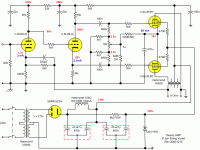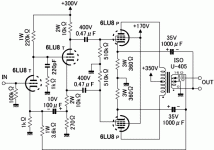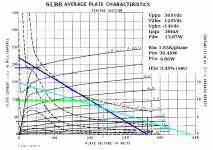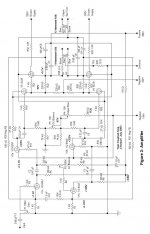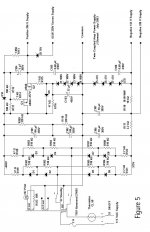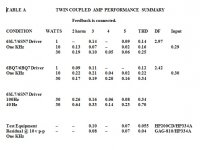Since all of Jan's pictures and schematics for this thread have mostly disappeared, and I found some info on it for another thread using the Wayback Machine, I'll re-post what I found again here.
Jan's old site info (1st pic):
6LU8 Sweep-AMP
Tony Tecson's thread on the same or similar design to Jan's:
tony's 6LU8 push-pull power amp build
There also was a 6LU8 version of Norman Crowhurst's "Twin Coupled Amplifier" by John Stewart in AudioXpress August 2004. Apparently it was a free download at one time, but it has to be requested now from AudioXpress.
Another similar 6LU8 design with CFB found on the Web (2nd pic):
????? vol
Jan's old site info (1st pic):
6LU8 Sweep-AMP
Tony Tecson's thread on the same or similar design to Jan's:
tony's 6LU8 push-pull power amp build
There also was a 6LU8 version of Norman Crowhurst's "Twin Coupled Amplifier" by John Stewart in AudioXpress August 2004. Apparently it was a free download at one time, but it has to be requested now from AudioXpress.
Another similar 6LU8 design with CFB found on the Web (2nd pic):
????? vol
Attachments
Hi,
anyone knows a vertical deflection output pentode that can be used as a phase inverter for a GU50 with shunt/Shade feedback? So it can be supplied by the 900 V B+ of the GU50s and swing 140 Vpp?
Thank you all in advance.
Roberto
anyone knows a vertical deflection output pentode that can be used as a phase inverter for a GU50 with shunt/Shade feedback? So it can be supplied by the 900 V B+ of the GU50s and swing 140 Vpp?
Thank you all in advance.
Roberto
Thanks smoking-amp,
I can’t find datasheets with curves for this amp, so I’ve found the datasheet of the 6ge5:
http://www.r-type.org/pdfs/6ge5.pdf
That based on your post here:
6GF5 sound fine in triode mode ?
Has the same curves, but seems not very linear.
Is there a way to improve its linearity? I’m looking for a phase inverter to drive GU50s in a shunt feedback power amp à la Baby Huey.
Thanks
I can’t find datasheets with curves for this amp, so I’ve found the datasheet of the 6ge5:
http://www.r-type.org/pdfs/6ge5.pdf
That based on your post here:
6GF5 sound fine in triode mode ?
Has the same curves, but seems not very linear.
Is there a way to improve its linearity? I’m looking for a phase inverter to drive GU50s in a shunt feedback power amp à la Baby Huey.
Thanks
Another vertical deflection VT that looks really good is the 6LR8. I have a bunch of these with 21V heaters. The audio loadline looks pretty good here, with some decent output. The h3 estimate is under 1%, and you have nearly 5W of Class A1 power.
The type also includes a small signal triode that can serve nicely as a cathode follower grid driver. I would expect this type to make an outstanding audio amp. The 1.65K/phase translates to a primary of 6.6K -- a stock value, so no need for a custom OPT either.
Negative feedback.
The type also includes a small signal triode that can serve nicely as a cathode follower grid driver. I would expect this type to make an outstanding audio amp. The 1.65K/phase translates to a primary of 6.6K -- a stock value, so no need for a custom OPT either.
Is there a way to improve its linearity?s
Negative feedback.
Attachments
Last edited:
Thanks Miles, I'm a newbie in Hi-Fi design, but this is clear. My question was more: "has anyone direct experience on make it linear?" I need around 120 Vpp.Negative feedback.
Since all of Jan's pictures and schematics for this thread have mostly disappeared, and I found some info on it for another thread using the Wayback Machine, I'll re-post what I found again here.
Jan's old site info (1st pic):
6LU8 Sweep-AMP
Tony Tecson's thread on the same or similar design to Jan's:
tony's 6LU8 push-pull power amp build
There also was a 6LU8 version of Norman Crowhurst's "Twin Coupled Amplifier" by John Stewart in AudioXpress August 2004. Apparently it was a free download at one time, but it has to be requested now from AudioXpress.
Another similar 6LU8 design with CFB found on the Web (2nd pic):
????? vol
I've put the article & a bit more into a pdf that's too big to fit here. See if I can tidy it up a bit in the next day or so. I also did an SET & SEUL with vertical toobz,😱
Attachments
I don't think there were many vertical tubes that handle 900V B+. Maybe just use the GU50 for a driver too.
Some "ultralinear" driver type N Fdbk to the 6GF5 screen grid could help linearize it. Or some N Fdbk to the cathode. A differential pair helps too. Or screen drive the tube, but need another driver for that then.
Some "ultralinear" driver type N Fdbk to the 6GF5 screen grid could help linearize it. Or some N Fdbk to the cathode. A differential pair helps too. Or screen drive the tube, but need another driver for that then.
Since you are looking at applying feedback to the LTP, I assume that you want an LTP. If the cathodes are lifted a couple hundred volts or so there are a few choices.
Many of the previously mentioned vertical sweeps have a DC plate voltage rating in the 300 to 450 volt range with a peak voltage range of 1200 to 1500 volts. These can often be operated well above the DC voltage rating with no ill effects provided the tube is not gassy.
There are some older vertical sweep triodes that have DC plate voltage ratings in the 500 - 550 volt range with peak ratings of 2000 volts. The 6CK4 and 6AH4 come to mind. The 6BL7 and 6BX7 are dual triodes with the same pinout as a 6SN7 and they will eat a lot of voltage too.
Many of the previously mentioned vertical sweeps have a DC plate voltage rating in the 300 to 450 volt range with a peak voltage range of 1200 to 1500 volts. These can often be operated well above the DC voltage rating with no ill effects provided the tube is not gassy.
There are some older vertical sweep triodes that have DC plate voltage ratings in the 500 - 550 volt range with peak ratings of 2000 volts. The 6CK4 and 6AH4 come to mind. The 6BL7 and 6BX7 are dual triodes with the same pinout as a 6SN7 and they will eat a lot of voltage too.
Jhstewart9, I’m wondering what the function is of Q1 in your power supply. Is it for safety reasons (overload / short)?
Regards, Gerrit
Regards, Gerrit
I wanted to build in some safety, the IFR840 is rated 500V max source to drain. At startup there is the possibility of exceeding that, so Q1 is slaved to Q2. Q2 is controlled by R116 & C103 for a slow HV turn on. When C103 is fully charged the HV is set by the zener string. Q2 becomes a source follower with low impedance output to the load. There are FETs now that would not require this hookup.
I built Crowhurst's amp out of curiosity. This one uses Crowhurst's front end but can be changed to a 2-stage differential front end, by switch on top of the chassis.
The amp manages 35 Watts at clipping. All done with 'Off The Shelf' parts, nothing Boutique in this one. And no tube selection, the test results are 'as is'.
The DF numbers would look better if I had used purpose built OPTs as Crowhurst did. The OPTs used are off the end in this cct.
For an ordinary 6LU8 PP stage running 400V plate & 300V screen the load impedance would be about 6K. UL at 300V, about 4.5K.
As usual people asked 'How Does It Sound?'. Like any properly operating amp it sounds as good as the speakers it is driving. What a surprise!!😱
I built Crowhurst's amp out of curiosity. This one uses Crowhurst's front end but can be changed to a 2-stage differential front end, by switch on top of the chassis.
The amp manages 35 Watts at clipping. All done with 'Off The Shelf' parts, nothing Boutique in this one. And no tube selection, the test results are 'as is'.
The DF numbers would look better if I had used purpose built OPTs as Crowhurst did. The OPTs used are off the end in this cct.
For an ordinary 6LU8 PP stage running 400V plate & 300V screen the load impedance would be about 6K. UL at 300V, about 4.5K.
As usual people asked 'How Does It Sound?'. Like any properly operating amp it sounds as good as the speakers it is driving. What a surprise!!😱
Attachments
Williamson on Cathode & Screen FB
I posted these papers on the forum about a year ago, so here they are again for those who may have missed that time. Also some worked examples of screen FB results as applied to some common tubes.
Looks to be very effective, just 10% UL lowers the plate resistance by 90%.🙂
I posted these papers on the forum about a year ago, so here they are again for those who may have missed that time. Also some worked examples of screen FB results as applied to some common tubes.
Looks to be very effective, just 10% UL lowers the plate resistance by 90%.🙂
DTN Williamson on Cathode & Screen FB
I posted these papers on the forum about a year ago, so here they are again for those who may have missed that time. Also some worked examples of screen FB results as applied to some common tubes.
Looks to be very effective, just 10% UL lowers the plate resistance by 90%.🙂
I posted these papers on the forum about a year ago, so here they are again for those who may have missed that time. Also some worked examples of screen FB results as applied to some common tubes.
Looks to be very effective, just 10% UL lowers the plate resistance by 90%.🙂
Attachments
-
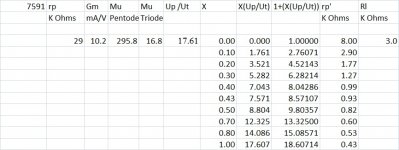 7591 rp vs UL FB Factor.jpg93.1 KB · Views: 151
7591 rp vs UL FB Factor.jpg93.1 KB · Views: 151 -
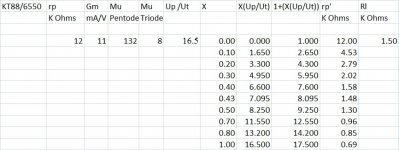 6550_KT88 rp vs UL FB Factor.jpg90 KB · Views: 152
6550_KT88 rp vs UL FB Factor.jpg90 KB · Views: 152 -
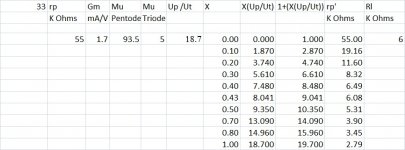 33 rp vs UL FB Factor.jpg89.1 KB · Views: 132
33 rp vs UL FB Factor.jpg89.1 KB · Views: 132 -
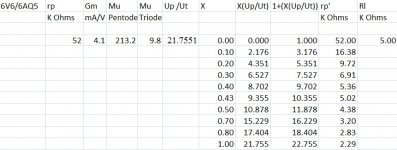 6V6_6AQ5 rp vs UL FB Factor.jpg88.6 KB · Views: 261
6V6_6AQ5 rp vs UL FB Factor.jpg88.6 KB · Views: 261 -
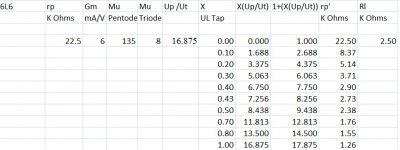 6L6 rp vs UL FB Factor.jpg85.3 KB · Views: 271
6L6 rp vs UL FB Factor.jpg85.3 KB · Views: 271 -
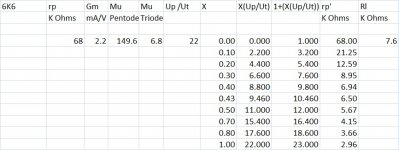 6K6 rp vs UL FB Factor.jpg90.1 KB · Views: 265
6K6 rp vs UL FB Factor.jpg90.1 KB · Views: 265 -
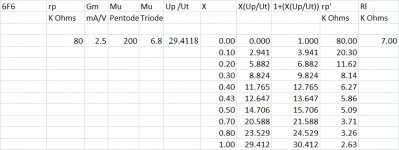 6F6 rp vs UL FB Factor.jpg91.2 KB · Views: 278
6F6 rp vs UL FB Factor.jpg91.2 KB · Views: 278 -
Amplifiers-and-Superlatives.pdf118 KB · Views: 160
-
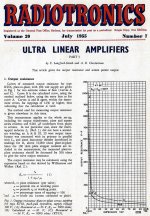 Calculation of Ultralinear Plate Resistance Radiotronics Magazine p1.jpg639.7 KB · Views: 185
Calculation of Ultralinear Plate Resistance Radiotronics Magazine p1.jpg639.7 KB · Views: 185 -
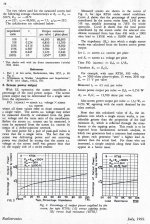 Calculation of Ultralinear Plate Resistance Radiotronics Magazine p2.jpg580.6 KB · Views: 189
Calculation of Ultralinear Plate Resistance Radiotronics Magazine p2.jpg580.6 KB · Views: 189
Thanks for the hint smoking-amp, I will check this option!Some "ultralinear" driver type N Fdbk to the 6GF5 screen grid could help linearize it. Or some N Fdbk to the cathode.
Thanks Tubelab, yes it's a LTP that drives GU50 in PP in UL through powerdrive with shunt/Shade feedback from GU50 plates to LTP plates.Since you are looking at applying feedback to the LTP, I assume that you want an LTP. If the cathodes are lifted a couple hundred volts or so there are a few choices.
Those would be perfect, thank you very much! From the curves ( https://frank.pocnet.net/sheets/093/6/6BL7GTA.pdf ) it seems I can configure it with CCS on cathodes (through a potentiometer to balance the two triodes), and two CCS on the plates too (like Fig. 2.49 at page 136 of Morgan Jones' Valve Amplifier design). 20 mA and -5V seem a possible working point to me for 120 Vpp (that's -43 V on GU50s' g1 plus some AB2).There are some older vertical sweep triodes that have DC plate voltage ratings in the 500 - 550 volt range with peak ratings of 2000 volts. The 6CK4 and 6AH4 come to mind. The 6BL7 and 6BX7 are dual triodes with the same pinout as a 6SN7 and they will eat a lot of voltage too.
Thanks jhstewart9, very helpful, I will prepare an excel file like yours too.Looks to be very effective, just 10% UL lowers the plate resistance by 90%.🙂
- Home
- Amplifiers
- Tubes / Valves
- Vertical deflection tubes for audio output?
